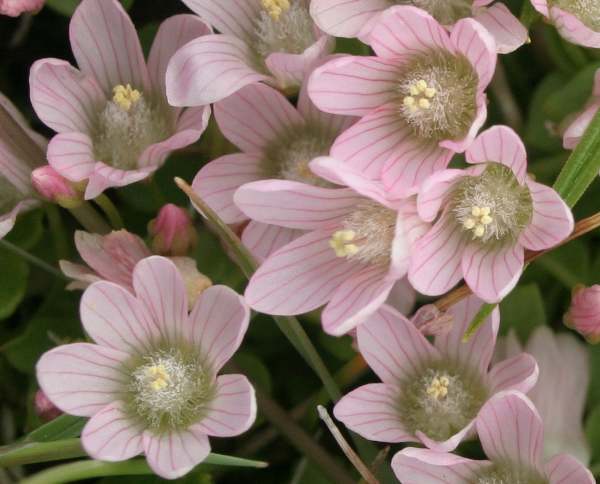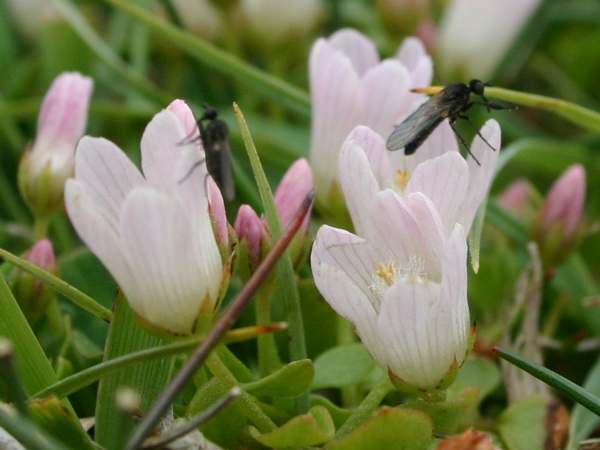Anagallis tenella - Bog Pimpernel
Phylum: Magnoliophyta - Class: Equisetopsida - Order: Primulales - Family: Primulaceae

So waxy and beautifully veined, these delightful little flowers are quite unlike most other members of the Primrose family.
Description
Once you get to see it at close quarters, this wildflower is quite unmistakable. Flowers are 6 to 10mm across with usually 5 to 7 lilac-pink round petals patterned with longitudinal red veins; they are backed by pointed short sepals. The centres contain a tangled mass of filamentous stamens.

Along the prostrate red-tinged stems are opposite pairs of leaves on shortish stalks; most leaves are roundish but some are shaped like the Ace of Spades.
A single flower grows on a short up-turned slender stalk at the end of each creeping stem, but when in full bloom the flowers of Bog Pimpernel all but obliterate the leaves, so densely are they packed together..
Distribution
In Britain and Ireland this lovely little wildflower is localised in the south and west; it is also found in Ireland where it is also most common on the western side.
Bog Pimpernel is found throughout most of Europe except in the far north and in arid parts of the south. Its range extends eastwards into Asia, but this wildflower is not native to North America.

Habitat
Anagallis tenella generally favours damp and acidic peaty substrates, but it can also be found in alkaline coastal dune slacks. As with all marsh and wetland plants, the enemy of Bog Pimpernel is land drainage.
Blooming Times
In Britain and Ireland Bog Pimpernel produces dense mats of flowers that open fully on sunny days from May right through to September.
Uses
Don't even think of picking these flowers; they are extremely fragile and likely to break as soon as they are touched. Cultivated forms of Bog Pimpernel are available from specialist garden centres and nurseries, and they make wonderful additions to any bog garden or to the waterlogged margin of a small pond.
Etymology
Anagallis, the genus name, comes from Greek and means 'to delight again' - a reference to the reopening of the flowers each day when the sun shines. The specific epithet tenella means 'delicate or tender', and this really is a very delicate 'don't touch or else' wildflower.
The photographs shown of Bog Pimpernel shown on this page were taken in Newborough Warren National Nature Reserve in Anglesey, North Wales, during July.
Sue Parker's latest ebook is a revised and enlarged second edition of the acclaimed Wildflowers in the Algarve - an introductory guide. Full details here...
Buy it for just £3.95 on Amazon...
Please Help Us: If you have found this information interesting and useful, please consider helping to keep First Nature online by making a small donation towards the web hosting and internet costs.
Any donations over and above the essential running costs will help support the conservation work of Plantlife, the Rivers Trust and charitable botanic gardens - as do author royalties and publisher proceeds from books by Pat and Sue.



